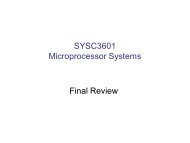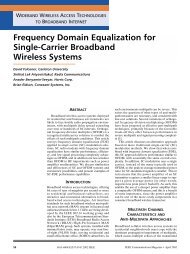Image Reconstruction for 3D Lung Imaging - Department of Systems ...
Image Reconstruction for 3D Lung Imaging - Department of Systems ...
Image Reconstruction for 3D Lung Imaging - Department of Systems ...
You also want an ePaper? Increase the reach of your titles
YUMPU automatically turns print PDFs into web optimized ePapers that Google loves.
6.1 Introduction<br />
EIT attempts to calculate a stable and accurate image <strong>of</strong> the conductivity or conductivity<br />
change within a medium from electrical measurements made on the medium boundary.<br />
Due to computational complexity, reconstructions have usually been over a 2D Finite Element<br />
Mesh (FEM). Continued improvements in computing power have permitted the recent<br />
exploration <strong>of</strong> <strong>3D</strong> reconstructions [90][98]. Electrode placement <strong>for</strong> 2D reconstruction algorithms<br />
is confined to planar arrangements that match the 2D reconstruction geometry;<br />
yet the EIT problem is inherently <strong>3D</strong> as currents cannot be confined to flow in the plane.<br />
Consequently 2D reconstructions are subject to artefacts generated by <strong>of</strong>f plane contrasts.<br />
<strong>3D</strong> reconstruction algorithms with multi-plane electrode arrangements have been used<br />
to more accurately reconstruct impedance distributions [90][98][113]. Dehghani et al in [41]<br />
investigated excitation patterns <strong>for</strong> applications <strong>of</strong> <strong>3D</strong> breast imaging using 64 electrodes<br />
arranged in four layers. Per<strong>for</strong>mance was evaluated in terms <strong>of</strong> singular value decomposition<br />
and qualitative evaluation <strong>of</strong> reconstructed images. Polydorides and McCann [99] developed<br />
and evaluated an electrode segmentation scheme <strong>for</strong> <strong>3D</strong> reconstructions. They examined<br />
the effects <strong>of</strong> the singular values <strong>of</strong> the Jacobian on the spatial resolution and concluded that<br />
the electrode segmentation scheme significantly improved the conditioning <strong>of</strong> the Jacobian<br />
and resulted in improved resolution.<br />
Many EIT research groups use 16 electrode systems using adjacent stimulation and<br />
measurement, based on the original configuration <strong>of</strong> [17] and [127]. This is the case, <strong>for</strong><br />
example, <strong>of</strong> the Goe-MF II adjacent stimulation tomography system (Viasys Healthcare,<br />
Höchberg, Germany) available in our lab. With the adjacent drive pattern the 16 electrodes<br />
are arranged equispaced in a single plane around the perimeter <strong>of</strong> the medium. Current is<br />
applied to an adjacent pair <strong>of</strong> electrodes and the resultant voltages between the remaining<br />
13 adjacent pairs <strong>of</strong> electrodes is measured. The three possible measurements involving<br />
one or both <strong>of</strong> the current injecting electrode are not used. This is repeated 16 times with<br />
current injected between successive pairs <strong>of</strong> adjacent electrodes until all 16 possible pairs <strong>of</strong><br />
adjacent electrodes have been used to apply the known current. This is shown schematically<br />
in figure 6.1. This procedure produces 16 × 13 = 208 voltage measurements called an EIT<br />
data frame. Since the electrodes are numbered 1 through 16 the adjacent pattern in 2D is<br />
obtained through a simple sequencing <strong>of</strong> the 16 machine leads to the 16 electrodes. This<br />
work is motivated by the desire to use such a 2D system to per<strong>for</strong>m <strong>3D</strong> EIT reconstructions.<br />
Compared to 2D there are many more ways to arrange and sequence electrodes when<br />
placing them in <strong>3D</strong>. Given the variety <strong>of</strong> possible <strong>3D</strong> electrode placement strategies, it is<br />
important to know which ones per<strong>for</strong>m best. However the large numbers <strong>of</strong> possibilities<br />
make this problem intractable. Consequently we choose to study a small set <strong>of</strong> possibilities<br />
guided by our intention to use the results <strong>for</strong> pulmonary imaging.<br />
In this paper we propose and evaluate seven EP configurations in which the electrodes are<br />
arranged in two parallel planes <strong>of</strong> eight electrodes each, with electrodes equispaced around<br />
the medium. We define an EP configuration as the combination <strong>of</strong> physical placement<br />
<strong>of</strong> the electrodes and current injection pattern. Different current injection patterns are<br />
obtained through various sequencings or mappings <strong>of</strong> the 16 electrode leads to electrodes.<br />
Per<strong>for</strong>mance is evaluated in terms <strong>of</strong> several figures <strong>of</strong> merit as well as immunity to noise and<br />
per<strong>for</strong>mance in the presence <strong>of</strong> electrode placement errors. The results apply to any medium<br />
which is approximately cylindrical; however, we are specifically interested in lung imaging<br />
78





